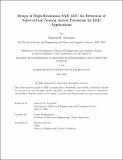Design of High-Resolution SAR ADC for Detection of Sub-Cortical Neuron Action Potentials for BMI Applications
Author(s)
Guobadia, Omozusi E.
DownloadThesis PDF (2.431Mb)
Advisor
Reiskarimian, Negar
Terms of use
Metadata
Show full item recordAbstract
The advancement of brain-machine interfaces (BMIs) requires neural signal acquisition systems that are capable of resolving both fast, low-amplitude action potentials (APs) and slow, higher-amplitude local field potentials (LFPs) under stringent power and area constraints. This thesis presents the design and simulation of a high-resolution, low-power successive approximation register (SAR) analog-to-digital converter (ADC) tailored for sub-cortical neural signal detection. To optimize dynamic range and reduce power consumption, a novel adaptive zoom-and-tracking architecture is introduced, enabling the ADC to dynamically adjust its reference window based on LFP trends while maintaining high-resolution capture of APs. The proposed system integrates a bootstrapped track-and-hold circuit, a differential capacitive DAC, and a strong-arm comparator in the analog front-end, alongside a digital FIR filter and SAR logic with zoom-range control in the digital domain. Simulations validate the functionality of each subsystem independently and in concert, demonstrating the system’s ability to dynamically isolate APs from LFP-dominated baselines while reducing analog power draw by over 60% compared to fixed-range ADCs. This work offers a promising approach for scalable, energy-efficient neural recording architectures suited to future BMI applications.
Date issued
2025-05Department
Massachusetts Institute of Technology. Department of Electrical Engineering and Computer SciencePublisher
Massachusetts Institute of Technology